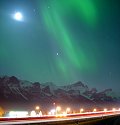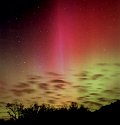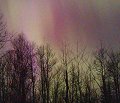
|
back to spaceweather.com |

|
|
Summary: On April 15, 2002, twisted magnetic fields above sunspot 9906 erupted and hurled a coronal mass ejection (CME) toward Earth. The expanding cloud reached our planet two days later and triggered a G2-class geomagnetic storm that raged for nearly 24 hours. Soon after the April 17th storm had subsided, a second CME struck Earth's magnetic field on April 19th. Like the one before it, this expanding cloud also came from sunspot 9906. The resulting geomagnetic storm lasted until mid-day (UT) on April 20th. |
| Photographer, Location | Images | Comments | |
 |
Dennis
Mammana, near San Diego, California, USA April 19 |
#1, more | D. Mammana: "Subtle? You bet! So subtle, in fact, that none of us could actually see these auroras with the unaided eye. But the indicators suggested that they would be there and, indeed, this digital camera image shows [the Northern Lights over southern California]." Photo details: 15-minute exposure on Fuji Provia 400F film at f/4 . |
 |
Ian Cooper,
Glen Oroua, Manawatu, N.I., New Zealand April 19 |
#1, #2, #3 | Photo details: 50mm lens @ f/1.4; Fuji Superia 400; 15 to 25 second exposures. |
 |
Brett Walker,
Chippewa Falls, Wisconsin, USA April 20 |
#1, #2 | The auroras were so intense over Wisonsin that Brett Walker was able to photograph them through the clouds. Photo details: Minolta DiMAGE 7; iso 800 f2.8; 4-10sec exposures. |
 |
Ron Giachetti,
40 miles northwest of Spokane, Washington, USA April 20 |
#1, #2, #3, #4 | R. Giachetti was pulled over by the Washington Highway Patrol on his way back from a midnight aurora shoot. "To get out of the ticket," says Giachetti, "I had to explain what an aurora was and show the officer my digital shots...." |
 |
Lara Triehy,
Pack Monadnock - 35 miles west of Manchester, New Hampshire,
USA April 20 |
#1, #2, #3 | Photo details: Pentax K1000, 50mm lens, f 2.8, 15-30 sec exposures, Kodak Max 400 |
 |
Mark Simpson,
Calgary, Alberta, Canada April 20 |
#1, #2, #3, #4, more | M. Simpson: "It wasn't even dark yet and I could still see the lights. Tonight I also saw the rare 'pulsing aurora.' You can also see the Moon and Jupiter in Photo #1." |
 |
Rick
Callahan, near Glover, Vermont April 20 |
#1, #2 | Photo details: Canon D30, 17-35mm lens, ASA 400 setting, 30 second exposure |
 |
John Carlson,
near Hutchinson, Minnesota, USA April 20 |
#1, #2, #3, #4 | Photo details: Nikon Coolpix 995; 30 to 50 sec exposures at 400 ASA. |
 |
Alan Stankevitz,
near La Crescent, Minnesota, USA April 17 |
#1, #2, #3 | A. Stankevitz: "This display had some unique characteristics. There were patches in the sky that would become luminescent on and off -- almost as fast as flashes of lightning. If you looked carefully, you could see the patches being illuminated from north to south in direction at approximately the same speed as a streaking meteor." |
 |
Carol Lakomiak,
Tomahawk, Wisconsin, USA April 17 |
#1, #2, #3, #4 | C. Lakomiak: "The intense auroral glow was evident soon after sunset and got better as twilight deepened, lasting for approximately 2 hours. Very nice display!" |
 |
Runar Sandnes,
Norway April 20 |
#1, #2, more | Photo details: "28mm lens, 15 sec. exposure on Kodak Supra 400" |
 |
Philippe
Moussette, Mont Cosmos Observatory in St-Elzéar Québec,
Canada April 20 |
#1, #2, #3, #4, #5, #6, more | Photo details: Coolpix 995 digital camera. |
 |
Larry
Spencer, Bellingham, Washington, USA April 20 |
#1 | L. Spencer: "I captured these photos last evening on my manual Pentax K1000, f2.8, 15 sec exposure time....film was Kodak max gold 800" |
 |
Kaleb Lund
& Brian Fronczak, on the shores of Lake Superior in Duluth,
Minnesota, USA April 19 |
#1, #2, #3, #4, #5 | B. Fronczak: "The auroras were moving fast -- they were pulsing and moving in waves at incredible speeds. It was enchanting!" |
 |
Todd Carlson,
Goodwood, Ontario, CANADA April 19 |
#1, #2 | Photo details: 28mm f2.8 lens using Fuji 800 for 25 seconds. |